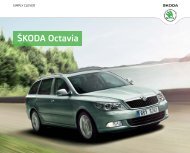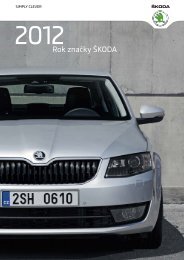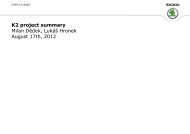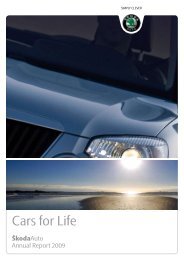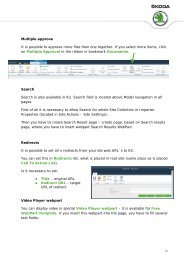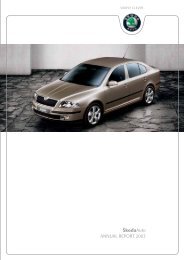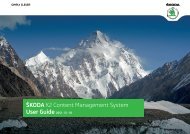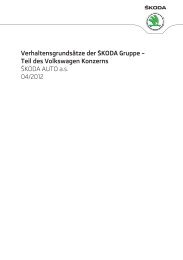Å kodaAuto ANNUAL REPORT 2006 - Skoda Auto
Å kodaAuto ANNUAL REPORT 2006 - Skoda Auto
Å kodaAuto ANNUAL REPORT 2006 - Skoda Auto
You also want an ePaper? Increase the reach of your titles
YUMPU automatically turns print PDFs into web optimized ePapers that Google loves.
1.3 Details of the Group<br />
In addition to ŠKODA AUTO a.s. located in Mladá Boleslav, the consolidated financial statements include all significant subsidiaries and<br />
associated undertakings.<br />
See Company information note for the Company’s details.<br />
Subsidiaries are all companies, in which the Company is able, directly or indirectly, to control financial and operating policies, which is the<br />
authority usually connected with holding majority voting rights. The existence and effect of potential voting rights that are currently<br />
exercisable or convertible are considered when assessing whether the Group controls another entity. The controlled companies<br />
(“subsidiaries”) are fully consolidated from the date on which control is transferred to the Group. They are de-consolidated from the date<br />
that control of the Group ceases.<br />
The significant subsidiaries of ŠKODA AUTO a.s. are as follows:<br />
– Škoda<strong>Auto</strong> Deutschland GmbH (100%),<br />
– ŠKODA AUTO Slovensko, s.r.o. (100%),<br />
– <strong>Skoda</strong> <strong>Auto</strong> Polska S.A. (51%),<br />
– <strong>Skoda</strong> <strong>Auto</strong> India Private Ltd. (100%)<br />
Associates are all entities over which the Group has significant influence but not control, generally accompanying a shareholding of<br />
between 20% and 50% of the voting rights. OOO VOLKSWAGEN RUS. is a significant associate of ŠKODA AUTO a.s.<br />
1.4 Consolidation principles<br />
The subsidiaries are consolidated by the full-scope consolidation method. Assets and liabilities of the companies of the Group included in<br />
the consolidated financial statements are recognised in accordance with the uniform accounting policies used within the Group.<br />
The purchase method of accounting is used to account for the acquisition of subsidiaries by the Group. The cost of an acquisition is<br />
measured as the fair value of the assets given, equity instruments issued and liabilities incurred or assumed at the date of exchange, plus<br />
costs directly attributable to the acquisition. Identifiable assets acquired and liabilities and contingent liabilities assumed in a business<br />
combination are measured initially at their fair values at the acquisition date, irrespective of the extent of any minority interest.<br />
The excess of the cost of acquisition over the fair value of the Group’s share of the identifiable net assets acquired is recorded as goodwill.<br />
If the cost of acquisition is less than the fair value of the net assets of the subsidiary acquired, the difference is recognised directly in the<br />
income statement.<br />
Inter-company transactions, balances and unrealised gains on transactions between group companies are eliminated. Unrealised losses<br />
are also eliminated unless the transaction provides evidence of an impairment of the asset transferred.<br />
Investments in associates are accounted for using the equity accounting and are initially recognised at cost. The Group’s investment in<br />
associates includes goodwill (net of any accumulated impairment loss) identified on acquisition.<br />
65



